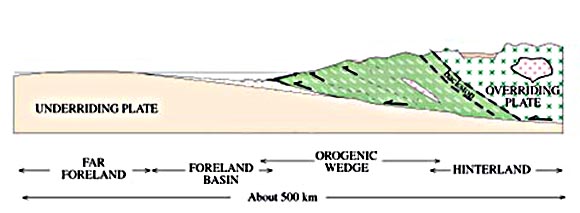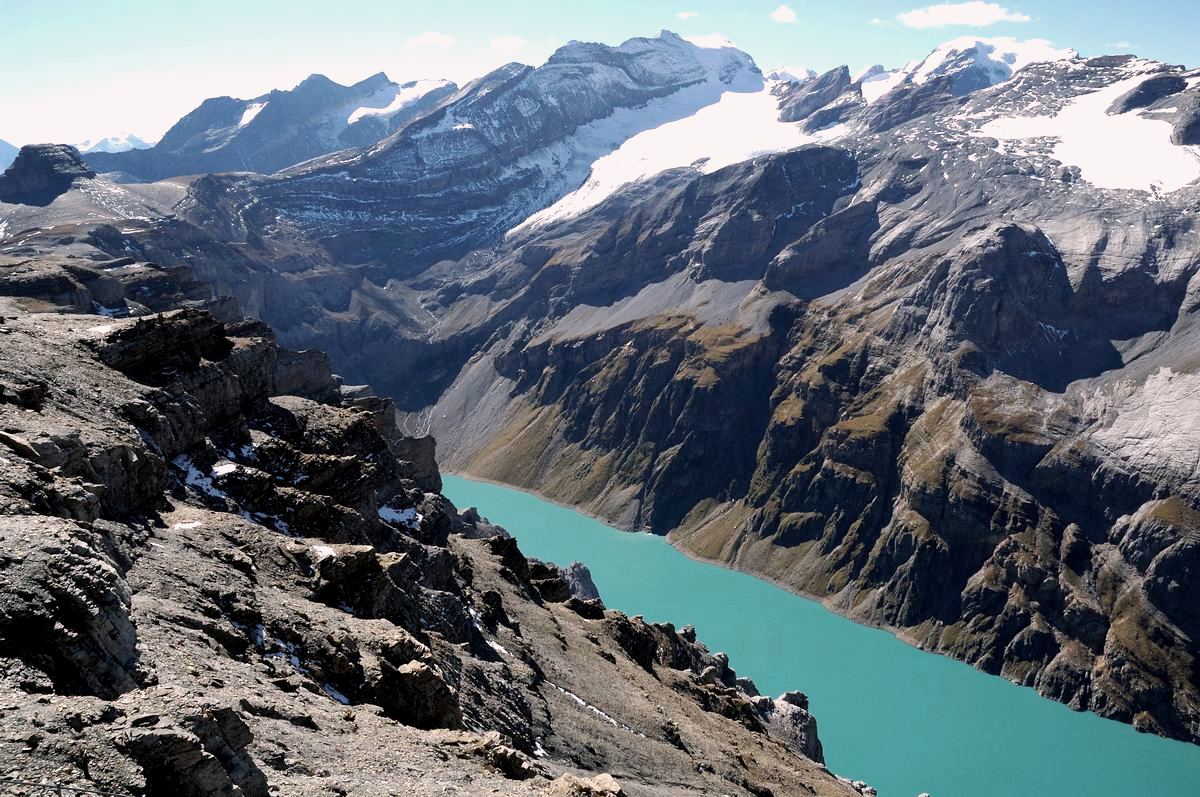|
Thrust Sheet
In geology, a nappe or thrust sheet is a large sheetlike body of rock that has been moved more than or above a thrust fault from its original position. Nappes form in compressional tectonic settings like continental collision zones or on the overriding plate in active subduction zones. Nappes form when a mass of rock is forced (or "thrust") over another rock mass, typically on a low angle fault plane. The resulting structure may include large-scale recumbent folds, shearing along the fault plane,Twiss, Robert J. and Eldridge M. Moores, ''Structural Geology,'' W. H. Freeman, 1992, p. 236 imbricate thrust stacks, fensters and klippes. The term stems from the French word for ''tablecloth'' in allusion to a rumpled tablecloth being pushed across a table. History Nappes or nappe belts are a major feature of the European Alps, Dinarides, Carpathians and Balkans. Since the 19th century many geologists have uncovered areas with large-scale overthrusts. Some of these were substan ... [...More Info...] [...Related Items...] OR: [Wikipedia] [Google] [Baidu] |
Thrust System En
Thrust is a reaction force described quantitatively by Newton's third law. When a system expels or accelerates mass in one direction, the accelerated mass will cause a force of equal magnitude but opposite direction to be applied to that system. The force applied on a surface in a direction perpendicular or normal to the surface is also called thrust. Force, and thus thrust, is measured using the International System of Units (SI) in newtons (symbol: N), and represents the amount needed to accelerate 1 kilogram of mass at the rate of 1 meter per second per second. In mechanical engineering, force orthogonal to the main load (such as in parallel helical gears) is referred to as static thrust. Examples A fixed-wing aircraft propulsion system generates forward thrust when air is pushed in the direction opposite to flight. This can be done by different means such as the spinning blades of a propeller, the propelling jet of a jet engine, or by ejecting hot gases from a rocke ... [...More Info...] [...Related Items...] OR: [Wikipedia] [Google] [Baidu] |
Marcel Alexandre Bertrand
Marcel Alexandre Bertrand (2 July 1847 – 13 February 1907) was a French geologist born in Paris. He was the son of mathematician Joseph Louis François Bertrand (1822–1900), and son-in-law to physicist Éleuthère Mascart (1837-1908). He studied at the École Polytechnique, and beginning in 1869 he attended the Ecole des Mines de Paris. From 1877 he carried out geological mapping studies of Provence, the Jura Mountains and the Alps. In 1886, he became an instructor at the École Nationale Supérieure des Mines, and in 1896 became a member of the Académie des sciences. Bertrand, a founder of modern tectonics, originated an orogenic "wave theory" of mountain-building and introduced the nappe hypothesis (). His wave theory described a build-up of massive folds of earth taking place over successive geological eras, called the Caledonian, Hercynian and Alpine periods of orogeny. Bertrand later added a fourth event called the Huronian orogeny, which took place 2400 to 2100 ... [...More Info...] [...Related Items...] OR: [Wikipedia] [Google] [Baidu] |
Erosion
Erosion is the action of surface processes (such as water flow or wind) that removes soil, rock, or dissolved material from one location on the Earth's crust, and then transports it to another location where it is deposited. Erosion is distinct from weathering which involves no movement. Removal of rock or soil as clastic sediment is referred to as ''physical'' or ''mechanical'' erosion; this contrasts with ''chemical'' erosion, where soil or rock material is removed from an area by dissolution. Eroded sediment or solutes may be transported just a few millimetres, or for thousands of kilometres. Agents of erosion include rainfall; bedrock wear in rivers; coastal erosion by the sea and waves; glacial plucking, abrasion, and scour; areal flooding; wind abrasion; groundwater processes; and mass movement processes in steep landscapes like landslides and debris flows. The rates at which such processes act control how fast a surface is eroded. Typically, physical ... [...More Info...] [...Related Items...] OR: [Wikipedia] [Google] [Baidu] |
Suture (geology)
In structural geology, a suture is a joining together along a major fault zone, of separate terranes, tectonic units that have different plate tectonic, metamorphic and paleogeographic histories. The suture is often represented on the surface by an orogen or mountain range. Overview In plate tectonics, sutures are the remains of subduction zones, and the terranes that are joined together are interpreted as fragments of different palaeocontinents or tectonic plates. Outcrops of sutures can vary in width from a few hundred meters to a couple of kilometers. They can be networks of mylonitic shear zones or brittle fault zones, but are usually both. Sutures are usually associated with igneous intrusions and tectonic lenses with varying kinds of lithologies from plutonic rocks to ophiolitic fragments. An example from Great Britain is the Iapetus Suture which, though now concealed beneath younger rocks, has been determined by geophysical means to run along a line roughly parall ... [...More Info...] [...Related Items...] OR: [Wikipedia] [Google] [Baidu] |
Duplex (geology)
Duplex (Latin, 'double') may refer to: Arts and entertainment * ''Duplex'' (film), or ''Our House'', a 2003 American black comedy film * Duplex (band), a Dutch electronic music duo * Duplex (Norwegian duo) * Duplex!, a Canadian children's music band * ''The Duplex'', an American comic strip by Glenn McCoy * ''The Duplex'' (film), a 2015 Nigerian film Places * Duplex, Tennessee, U.S. * Duplex, Texas, U.S. Science and technology * ''Duplex'' (moth), a genus of moths in the family Erebidae * Nucleic acid double helix, a double-stranded molecule of DNA or RNA * Duplex (telecommunications), communications in both directions simultaneously * Duplex (typography), a Linotype technique * Duplex ultrasonography, a medical imaging technique * Google Duplex, an extension of Google Assistant Transportation * Duplex (automobile), an early car built in Canada in 1923 * Duplex locomotive, a type of steam locomotive * TGV Duplex, a French high-speed train of the TGV family featuring bi- ... [...More Info...] [...Related Items...] OR: [Wikipedia] [Google] [Baidu] |
Charles Lapworth
Charles Lapworth FRS FGS (20 September 1842 – 13 March 1920) was a headteacher and an English geologist who pioneered faunal analysis using index fossils and identified the Ordovician period. Biography Charles Lapworth was born at Faringdon in Berkshire (now Oxfordshire) the son of James Lapworth. His school in Galashiels in 2021 He trained as a teacher at the Culham Diocesan Training College near Abingdon, Oxfordshire. He moved to the Scottish border region, where he investigated the previously little-known fossil fauna of the area. He was headmaster of the school in Galashiels from 1864 to 1875. In 1869 he married Janet, daughter of Galashiels schoolmaster Walter Sanderson. Through mapping and innovative use of index fossil analysis, based on a sequence exposed at Dob's Linn, Lapworth showed that what was thought to be a thick sequence of Silurian rocks was in fact a much thinner series of rocks repeated by faulting and folding. He completed this pioneering ... [...More Info...] [...Related Items...] OR: [Wikipedia] [Google] [Baidu] |
Scotland
Scotland (, ) is a country that is part of the United Kingdom. Covering the northern third of the island of Great Britain, mainland Scotland has a border with England to the southeast and is otherwise surrounded by the Atlantic Ocean to the north and west, the North Sea to the northeast and east, and the Irish Sea to the south. It also contains more than 790 islands, principally in the archipelagos of the Hebrides and the Northern Isles. Most of the population, including the capital Edinburgh, is concentrated in the Central Belt—the plain between the Scottish Highlands and the Southern Uplands—in the Scottish Lowlands. Scotland is divided into 32 administrative subdivisions or local authorities, known as council areas. Glasgow City is the largest council area in terms of population, with Highland being the largest in terms of area. Limited self-governing power, covering matters such as education, social services and roads and transportation, is devolved from the ... [...More Info...] [...Related Items...] OR: [Wikipedia] [Google] [Baidu] |
Maurice Lugeon
Maurice Lugeon FRS(For) HFRSE FGS (10 July 1870 – 23 October 1953) was a Swiss geologist, and the pioneer of nappe tectonics. He was a pupil of Eugène Renevier. Named for Maurice Lugeon, the lugeon is a measure of transmissivity in rocks, determined by pressurized injection of water through a bore hole driven through the rock. One Lugeon (Lu) is equivalent to one litre of water per minute, injected into 1 metre of borehole at an injection pressure of 10 atmospheres. Life He was born in Poissy near Paris on 10 July 1870. His family moved to Lausanne in Switzerland in 1876. From the age of 15 he showed a strong interest in geology. He spent most of his academic life at the University of Lausanne becoming Professor of Geology in 1906. He retired in 1940. He became an expert on dam locations and was consulted widely on this. He died in Lausanne Lausanne ( , , , ) ; it, Losanna; rm, Losanna. is the capital and largest city of the Swiss French speaking canton of Vaud. It ... [...More Info...] [...Related Items...] OR: [Wikipedia] [Google] [Baidu] |
Switzerland
; rm, citad federala, links=no). Swiss law does not designate a ''capital'' as such, but the federal parliament and government are installed in Bern, while other federal institutions, such as the federal courts, are in other cities (Bellinzona, Lausanne, Lucerne, Neuchâtel, St. Gallen a.o.). , coordinates = , largest_city = Zurich , official_languages = , englishmotto = "One for all, all for one" , religion_year = 2022 , religion_ref = , religion = , demonym = , german: link=no, Schweizer/Schweizerin, french: link=no, Suisse/Suissesse, it, svizzero/svizzera or , rm, Svizzer/Svizra , government_type = Federal assembly-independent directorial republic , leader_title1 = Federal Council , leader_name1 = , leader_title2 = , leader_name2 = Viktor Rossi , legislature = Federal Assembly , upper_house = Counci ... [...More Info...] [...Related Items...] OR: [Wikipedia] [Google] [Baidu] |
Glarus Alps
The Glarus Alps (german: Glarner Alpen) are a mountain range in central Switzerland. They are bordered by the Uri Alps and the Schwyz Alps to the west, the Lepontine Alps to the south, the Appenzell Alps to the northeast. The eastern part of the Glarus Alps contains a major thrust fault that was declared a geologic UNESCO World Heritage Site (the Swiss Tectonic Arena Sardona). The Glarus Alps extend well beyond the canton of Glarus, including parts of the cantons of Uri, Graubünden, and St Gallen. Conversely, not all the mountains in the canton of Glarus are part of the Glarus Alps, with those to the north of the Urner Boden and to the west of the valley of the river Linth considered to be part of the Schwyz Alps. Geography The main chain of the Glarus Alps can be divided into six minor groups, separated from each other by passes, the lowest of which exceeds 7,500 ft. The westernmost of these is the Crispalt, a rugged range including many peaks of nearly equal he ... [...More Info...] [...Related Items...] OR: [Wikipedia] [Google] [Baidu] |





